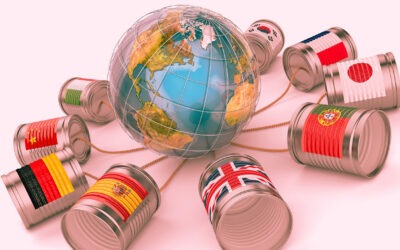Artificial intelligence (AI) has come a long way in recent years, thanks to the increase in processing capacity, the development of algorithms, and the availability of huge amounts of data.
One of the most popular and useful applications of AI is Machine Translation or MT, which consists of converting text or speech from one language to another using grammar rules, dictionaries, and statistical or neural models.
MT can facilitate communication, learning, and access to information between speakers of different languages and cultures. However, with no human translators involved, relying on MT alone can be a really bad decision.
One of MT’s many limitations is gender bias. 🧔🏻♂️👧🏻♀️
Gender is a social and cultural construct that defines the roles, behaviors, and identities of men and women in society.
🤹🏻💃🏻👨🏽👦🏽👦🏽👨🏾🏫👷🏼♀️👩🏿👧🏿
It’s also a grammatical category that assigns a masculine or feminine value to a noun, pronoun, adjective, or verb, depending on the language.

Gender bias is a tendency to favor or discriminate against one gender over another, consciously or unconsciously, intentionally or unintentionally. Gender bias can occur in various contexts, such as education, work, the media, politics, etc.
Translating something that is gender-neutral in a given language into a language where it will be gender-specific can be tricky for humans, but it’s a lot trickier for a computer.
Data can contain stereotypes, prejudices, or gender inequalities that are inadvertently reproduced or even amplified by the algorithms.
An example was when Google Translate was accused by the public of stereotyping based on gender, assuming things like all doctors are male and all nurses are female, suggesting that there is a gender imbalance in the translation industry and that online translation tools are reflecting or reinforcing it. 👨🏻⚕️👩🏼⚕️💉
Tools like Google Translate and Microsoft Translate, two of the most widely used machine translation services in the world, often assign gender stereotypes to certain words or professions, such as doctor or nurse, engineer, or professor, and they use masculine forms as the default for gender-neutral words for professions traditionally considered more appropriate for men. These translations are inconsistent and biased, often using masculine forms for words that were feminine or neutral in the original language, or vice versa.
This can have negative consequences for the perception, appreciation, and inclusion of women and other gender groups in society in many parts of the world. 🌍

Because machine translators have learned from biased data, which originally came from humans, they end up being prejudiced to perceive words as male or female. However, there’s more to this.
The majority of machine learning algorithms are built to favor typicality and overgeneralize. Therefore, if the machine interprets “nurse” as “female nurse” 75% of the time in the training data (assuming there are no contextual cues regarding gender), it will translate it as such 100% of the time.
This means machine translation systems not only mimic pre-existing prejudices, but they also intensify them.
The role of heuristics
Heuristics are quick and easy mental shortcuts, or generalizations, that frequently defy logic to form judgments and conclusions. In simple words, they are shortcuts or rules of thumb that assist in finding approximate solutions to complex issues. They can be useful for making quick decisions, but they frequently lead to incorrect or illogical conclusions.
Humans use heuristics, which can be helpful in certain circumstances but can also result in cognitive biases—systematic mistakes in thought that influence our opinions and decisions.
Artificial intelligence (AI) also employs heuristics when it is difficult or impractical to find an exact answer or whenever speed is more important than accuracy. Heuristics are used by AI systems, for instance, to play chess.
AI picks up bias through reading, evaluating, and classifying preexisting data that has been fed to it by humans.
Representativeness, inclusion, and diversity
Our world is plural and diverse, and the existence of different cultures, races, genders, sexual orientations, and religions enriches society and allows people to learn from their differences and become more tolerant. 👩🏼🚀🚀
Representativeness is the quality of representing or reflecting the diversity of a group or society, whether in terms of gender, race, culture, religion, sexual orientation, etc.
Representativeness is an essential factor in promoting respect, tolerance, and solidarity, and in guaranteeing the rights and dignity of all. Seeing people from different genders, ethnic and cultural backgrounds, etc. in various social settings, such as work, politics, or media, can help overcome prejudice. It can also motivate minorities to pursue their goals by seeing people who resemble them or have similar experiences in influential roles.

Inclusion is the practice of ensuring that everyone has equal access to the rights, opportunities, and resources that society offers. Inclusion fosters equality, justice, and respect for human diversity. It also enriches society as a whole as it enables people to share their skills and potential for social, economic, and cultural progress.
Diversity in society is a source of wealth, learning, and transformation. It encourages us to challenge our biases, expand our perspectives, and acknowledge the worth of each individual.
It also invites us to celebrate our commonalities and our differences, helping us to build a more diverse and supportive society.
Diversity is a fundamental element in building a fairer and more inclusive society.

So, how can we avoid machine translation gender bias?
Machine translation should be improved in order to reflect, recognize, respect, and preserve the linguistic and also human and cultural diversity that exists in the world.
After all, MT is meant to facilitate access to information, education, and communication between people of different languages and cultures, promoting dialogue, cooperation, and integration. It was created to bring people closer, not further apart. 🧑🏻🤝🧑🏿
For machine translation to fulfill its role, AI systems must be developed with the criteria of quality, ethics, and social responsibility. The data used to train AI systems must be representative, balanced, and free of bias.
The algorithms used to process the data must be transparent, auditable, and correctable.
Users of machine translation services must be aware, critical, and participative.
This is another limitation that shows a human professional should always be involved in the translation process, using AI as a tool to enhance productivity, not as a replacement for human professionals or an excuse not to be thorough.
Nonetheless, no matter how intelligent an artificial intelligence is, it will never be able to determine a person’s gender if the input lacks any indicators. When a human translator realizes they need to know someone’s gender for translation, they will attempt to find out. AI will resort to heuristics and generalization.
In short, artificial Intelligence is a powerful and promising technology that can bring benefits and opportunities to translation, but it also presents risks and challenges that require human attention, care, and action. AI is neither neutral, infallible, nor impartial. It’s a reflection and product of human society, which is complex, dynamic, and diverse, but also has many issues, like discrimination, prejudice, racism, sexism, etc.
Human society needs to harness the potential, beauty, and richness of artificial intelligence while prioritizing diversity, creativity, and humanity. We need to take on the responsibility and commitment to properly develop, use, evaluate, and control artificial intelligence in an ethical, fair, and inclusive way, without losing sight of human values, principles, and rights.
Be sure to come back to our blog to read more on this and other subjects, follow us on social media, and/or subscribe to our newsletter here.






0 Comments